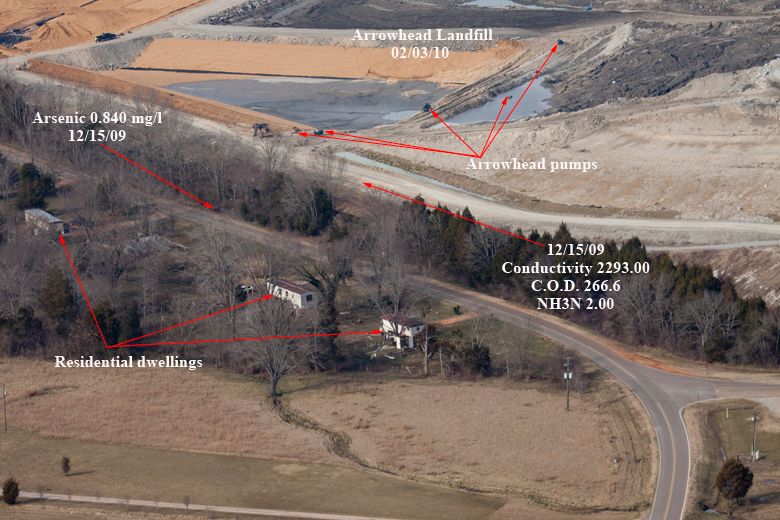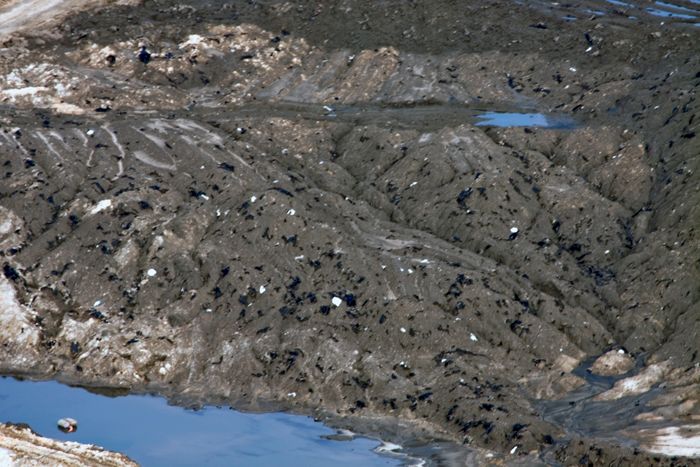60 Minutes Investigates a Potentially Harmful Waste Byproduct that Inundated a Tenn. Town
(CBS) Asked how he lives now and whether he goes out on the water, Topmiller said, "No. We don't go out of the house."
From the house, he sees scientists collecting samples to analyze just how bad the water is. The river looks clear, but Topmiller says it's deceptive.
He shows Stahl a water sample he collected himself in a jar. "Turn it upside down and start shakin’ it. And this is what the river looks like once it - once that stuff gets suspended in it," Topmiller said. As Stahl shakes the jar gray muck inside clouds the seemingly clear water. "And how they're gonna get that all out of the river, I don't have an idea."
Most of his neighbors have packed up and left. Go down the river and you pass home after home that are deserted, the hubbub of children replaced by the hum of heavy machinery.
Those left behind say the noise is one thing: what really infuriates them is executives from the power plant telling them that coal ash is as safe as dirt.
"We have broken the trust," Anda Ray said.
Ray oversees environmental policy at the Tennessee Valley Authority, which is responsible for the spill. Stahl asked her how toxic she thinks coal ash is.
"I'd say that the constituents, the things that are in the coal ash, are the same things that are naturally occurring in soil and rock," Ray replied.
"So, is it like dirt? Would you say that? Would you say that sentence? That stuff is like dirt," Stahl asked.
"That ash material is higher than dirt in two areas. And that is arsenic and thallium. And we are monitoring those and the effect on the water," Ray said.
Asked if she would swim in the river now, Ray told Stahl, "Yes, I would."
She later retracted, remembering there’s an advisory against it. "We've advised people not to swim in the river where there's ash."
Stahl then asked about company reports repeatedly questioning the stability of the ash ponds.
"Should the TVA have seen this coming?" Stahl asked. "You were warned repeatedly."
"Lesley, there were red flags that have been noticed all through the years. And we recognize that those red flags should've been addressed. But yes, we missed them, and we don't ever want to miss them again," Ray replied.
The spilled ash is now being loaded onto trains and sent off to a dry landfill in Alabama. Right now, coal ash disposal is regulated by the states, some of which have strict rules, some hardly any at all.
If this is a dry landfill, where did all the water come from?
Why are there 4 hugh volume pumps in this one photo?
(JLW)
The new head of the EPA, Lisa Jackson, is reviewing whether the federal government should get involved by labeling coal ash a "hazardous waste," which would mean much tighter regulations and oversight.
"Why wouldn't you right now, this minute, on
60 Minutes, declare that coal ash is a hazardous waste?" Stahl asked.
"EPA, in making a regulatory determination, has to look at a number of factors, including the toxicity of the material and how it's currently managed, but that's done according to law. And I have committed that no later than December, we will make a regulatory proposal with respect to this material," Jackson explained.
The industry opposes calling coal ash a hazardous waste. They're pushing for another solution: recycling.
(CBS) Ted Yoakam, a lawyer in Virginia, says recycling can breed its own disaster. He says that in 2002, the state's power company, Dominion, got rid of some of its excess coal ash by giving it to a golf course in Chesapeake.
"How many tons of coal ash, do you know, did they use to build this golf course?" Stahl asked.
"We know that they put at least 1.5 million tons," Yoakam said.
In a videotaped city council meeting, a consultant hired by the company that built the golf course assured the mayor that coal ash was safe for reuse.
"In every aspect it's the same as dirt, as it's been explained to me. I'm not aware of any negative aspects of it at all," the consultant explained.
The mayor then turned to a Dominion executive.
Asked if there are any environmental concerns, the executive told the mayor, "No, sir. We at Dominion Power are fully in compliance with all the federal and state regulations."
Two years later, an internal company study about handling the ash for the golf course recommended that workers use "impervious gloves" and "particulate-filtering respirators" due to "potential health...risks."
Robyn Pierce and her neighbor Stacy Moorman live across the street from the golf course.
"It was said that they were told respirators and body suits. Nobody came up and down either one of these two streets and handed out wardrobe for us," Pierce said.
"But our children were out there," Moorman remarked.
"Our children were out there playing in the yard breathing this stuff. How does this happen?" Pierce asked.
Also, Dominion's internal risk assessment warned of the dangers of coal ash leaching into the water supply. To prevent that, the contractor who built the golf course was supposed to build a two-foot barrier under the coal ash, and one 18 inches on top.
The contractor's engineer certified this was done. But attorney Ted Yoakam, who represents townspeople who are suing Dominion, suspects it wasn’t.
"Yes. As you can see right here, it's right at the surface," Yoakam said, pointing out to little mounds of coal ash on the surface of the grass. "Insects have pulled it up. You can see how it flies away."
Last year, the city dug into the golf course, did a test and found elevated levels of toxic metals in the water.
"With all the knowledge that Dominion had about the coal ash and the lead and the arsenic and beryllium and all the poison to put it in this environment, it's just an outrage," Yoakam said.
That water test was just for the golf course; Dominion told
60 Minutes EPA testing "shows no harm to residential wells" around the golf course.
In reply to that argument, Stacy Moorman says: "I invite anybody from the companies who have put it over there to come to my house and have dinner. And I will use that tap water."
Moorman and her neighbors think it's too risky to drink the water. So, after Dominion refused to provide them with bottled water, they began trudging to a local church, where the city pipes in guaranteed clean water.
Dominion declined to give
60 Minutes an interview, but most power companies rely on recycling because it cuts the 130 million tons of coal waste every year in half. The industry calls recycling "beneficial use."
"Ugh! Don't even… The only people it was beneficial for were for those utility companies that had to get that stuff off their hands because they were already in violation with stockpiling too much. That is what 'beneficial use' meant," Robyn Pierce said.
But the EPA in the Bush administration endorsed beneficial use and now coal ash is recycled in dozens of ways: as cement substitute, it's also placed under roads and in deserted mines and it's added to products from carpets to bowling balls to bathroom sinks.
(CBS) While the industry says the uses have been studied, Stahl asked Lisa Jackson whether the EPA knows if some of the recycled products are safe.
"Schoolroom carpeting," Stahl asked.
"I don't know. I have no data that says that's safe at this point," Jackson replied.
"Kitchen counters," Stahl asked.
"The same," Jackson replied.
"Fifty thousand tons of coal ash byproducts have been used in agriculture. What's being done through EPA to look at the use of coal ash in agricultural products? Anything? Is there a study?" Stahl asked.
"I'm not sure that there's any study out there right now," Jackson said.
"How did we get to a place where coal ash is in products without anybody knowing?" Stahl asked.
"We're here, now, because coal ash at this time isn't a regulated material by the federal government," Jackson replied.
If the EPA declares coal ash a hazardous waste, lobbyist Jim Roewer says "beneficial use" would die and the cost of disposal would skyrocket.
"We look at that and we’re looking at something on the order of 12 to 13 billion," he explained.
"And who'd pay for that?" Stahl asked. "We know. The customers."
"Environmental protection doesn't come cheap," Roewer replied.
He says the current state-by-state regulatory system may not be perfect, but it works.
"Could you say right now that the disposal in all the coal ash plants today are safe, and that they're all doing a proper job?" Stahl asked.
"All I can guarantee is that they're going [to] do their best to manage coal ash safely so that you don't have a release like Kingston," Roewer replied.
Asked if all these plants are safe, Roewer said, "That's what the state regulations are all about to insure the safe management of coal ash."
"But you're not saying they are safe. You're playing word games with me. You're not saying, 'They are safe,'" Stahl said.
"You want me to guarantee that…they're absolutely safe," Roewer asked.
"I think everybody…yes, I do," Stahl replied.
"Well, what I can say is the state regulations and the utility management practices are put in place to ensure with a goal of safe management of coal ash," Roewer said.
"I don't think many people really trust the utility industry, I'm sorry to tell you," Stahl remarked.
Roewer's reply? "You're not the first one to tell me that."




























 The town of Kingston, Tenn. was flooded with coal ash when a a giant retention pool containing the substance buckled in December 2008. (CBS)
The town of Kingston, Tenn. was flooded with coal ash when a a giant retention pool containing the substance buckled in December 2008. (CBS)




